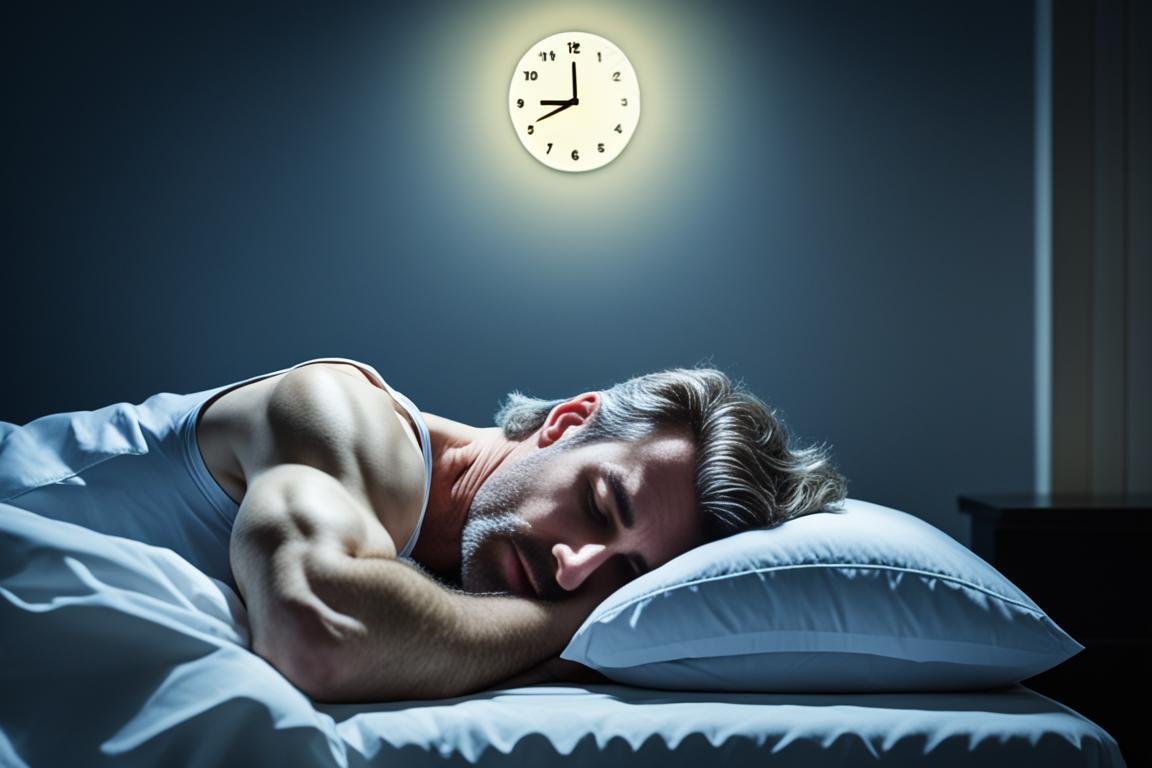Waking up with upper back pain after a good night’s sleep is really annoying. It’s quite common and can point to the need for sleep style changes. It’s also a sign to keep your back muscles strong. Sometimes, other health issues might be causing the pain. And these need proper treatment too.
There are many reasons why you might have upper back pain after sleep. These include bad sleep posture, muscle stress and tension, carrying too much weight, and sleeping in ways that hurt your back muscles. An unsupportive mattress can also be a cause. Most cases get better with time and some self-care. But, if the pain is due to something more serious, like an injury or arthritis, you should get professional advice.
Key Takeaways
- Poor sleeping posture can lead to upper back pain and affect your body’s ability to relax and rejuvenate.
- Injuries, pinched nerves, and arthritis can also contribute to upper back pain after sleeping.
- Maintaining a neutral spine and using supportive pillows and mattresses is crucial for preventing pain.
- Proper sleeping positions, such as on your back or side, can help alleviate upper back pain.
- Seeking professional help from a chiropractor or physical therapist can provide natural solutions for upper back pain.
Understanding the Causes of Upper Back Pain After Sleeping
Waking up with upper back pain is common. Many things like how you sleep, your mattress and pillows, and stress can cause it. Knowing these causes helps find ways to sleep better and lessen the pain.
Poor Sleeping Posture
How you sleep is important for avoiding upper back pain. If you sleep in a way that’s not good for your spine, you can hurt your upper back. This may make your back feel stiff and sore in the morning.
Unsupportive Mattress and Pillows
A bad mattress or pillows can also make your upper back hurt. A mattress that’s too old or soft can mess up your spine’s shape. This causes your upper back to feel strained. Wrong pillows can also hurt your neck and upper back.
Stress and Muscle Tension
Feeling stressed can tighten muscles in your upper back. This can happen if you’re worried or anxious. It can lead to aches and pains, especially when you wake up. Finding ways to relax can help with this pain.
Improving Sleep Posture for Back Pain Relief
Want to lessen your upper back pain from sleep? Find a good sleep posture. You need to support how your spine lines up. The right sleep position and pillows can help your back and neck. This lets your muscles rest and heal while you sleep.
Maintaining a Neutral Sleeping Position
The ideal sleep position is one that doesn’t twist or bend your spine. Sleep on your back if you can. It’s the best way to keep your spine straight. Use a pillow that fits the curve of your neck. This keeps your head and upper back in line.
Side sleeping is okay, too. Just put a pillow between your knees. It stops your upper legs from turning your spine. This keeps your spine’s curve and eases the pressure on your back.
Don’t sleep on your stomach. It stresses your upper back and neck the most. If you must, use a thin pillow or none under your head. This helps your neck stay straight.
Pillow Placement for Spinal Alignment
Move your pillows right to help your back feel better. For back sleepers, use a rounded pillow under your neck. It keeps your neck in line. Put a flatter pillow under your head.
If you sleep on your side, place a pillow between your knees. It keeps your spine level and stops your leg from pulling your back out of line. Make sure your hips, shoulders, and neck are at the same height by adjusting the pillow.
Try different pillows to see what’s comfy for you. Find ones that keep your spine, neck, and back in a good, straight position all night long.
Creating a Supportive Sleep Environment
Your pillows and mattress matter a lot for a good night’s sleep without neck and upper back pain. A top-notch mattress will let you sleep comfortably, keeping your spine in a good position. Likewise, the right pillows reduce stress and soreness in your upper body. It doesn’t matter if you sleep on your back, side, or stomach, the right pillow can keep your neck in a good spot. This means your whole spine stays aligned as you sleep.
Choosing the Right Mattress
The best mattress is key to a pain-free morning. It should fit the shape of your spine and evenly support your body weight. Always choose a mattress quality that fits how you sleep and what you like. This is vital to having a cozy and painless time at night.
Selecting Appropriate Pillows
Don’t forget about the pillow support. It’s as important as picking the right mattress. Pillows must keep your head, neck, and shoulders straight, no matter if you sleep on your back, side, or stomach. Try different kinds of pillows to see which works best for you. This way, you get the support and comfort you need for a good night’s rest.
upper back pain after sleeping
Sleeping Positions for Upper Back Pain
Good sleeping posture is key to lessening upper back pain. Sleep on your back to keep your spine in line. You should use a pillow that keeps your neck and head in line with your back.
Avoid pillows that are too high or too flat. These can hurt your neck muscles. For side sleeping, pick a pillow that supports your head and neck properly. This will keep them in line with your upper back.
Sleeping on your stomach can be bad for your back. If you have to sleep this way, use a thin pillow or no pillow. This stops your neck from being twisted too much.
Identifying and Addressing Underlying Conditions
Sometimes, upper back pain comes from other issues like recent injuries or arthritis. If your pain doesn’t go away, see a doctor. They will figure out what’s wrong and help you feel better.
Stretching and Strengthening Exercises
Adding upper back stretches can help relieve upper back pain. They work well against many reasons for the pain. Doing warm-up exercises first, like moving and doing cardio, get your body ready. But doing long stretches can make your muscles weaker for a bit.
Gentle Stretches for Upper Back Relief
Before working out, do some easy stretches for the neck and shoulders. Each stretch should last 30 seconds to 1 minute. This helps ease pain and makes tight muscles looser. Changing up your exercises keeps things interesting and helps your body move better.
Strengthening Core and Back Muscles
It’s key to strengthen your upper back and shoulders to fight and stop pain. Do 2-3 sets of 8-12 reps for moves like rows and reverse dumbbell flies. After your workout, try some slow stretches to keep flexible. Moves like the Pec stretch and Child’s Pose are good for your chest and shoulders.
Doing both kinds of stretches can really help with upper back pain relief and keeping discomfort away. Make sure to do what feels right for your body.
Stress Management Techniques
Stress and anxiety make your muscles tight. This can hurt your upper back. Including stress management tips daily can help you relax. It can give you some relief too.
Try deep breaths to calm your mind and loosen your muscles. This makes a big difference. Also, try meditating. Spend a couple of minutes each day focusing on your breath. It helps get rid of mental and physical stress.
Gentle yoga is great for reducing stress. It includes moving, stretching, and being mindful. This can lower your back pain. And it makes you more aware of your body.
Dealing with the stress helps your back pain a lot. Use these tips every day. You’ll feel better and sleep better too.
Heat and Cold Therapy for Upper Back Pain
Putting a heating pad or cold pack on your upper back can lower swelling. It also helps with muscle soreness. Try both heat therapy and cold therapy to find what works best for your upper back pain.
Benefits of Applying Heat
Heat makes muscles relax and feel better. It gets more blood flowing to the spot, bringing more nutrients. This can help with feeling stiff in the morning. Using a heat pad, hot water bottle, or warm bath is a good idea for upper back pain relief.
When to Use Cold Therapy
Cold therapy lessens swelling and numbs the pain. It’s great for recent back injuries, exercise pain, or sciatica flare-ups. A cold pack or ice rub can quickly help with joint pain and stiffness.
It’s key to see how your body reacts and try what works for your upper back pain. Using both heat and cold at the right times can help a lot. This is a good way to relieve your discomfort at home.
Seeking Professional Help
If your upper back pain keeps on or gets worse, see a healthcare provider. They will check your problem and suggest what to do, based on what you need. Always get help if your back pain makes daily life hard, or if it ruins your sleep.
Consulting with a Healthcare Provider
When you go to a healthcare provider, they’ll look into what’s causing your upper back pain. They might touch and check you, look at your past health, and maybe do tests like X-rays. Then, they can tell what’s wrong and how to treat it.
Physical Therapy for Upper Back Pain
Physical therapy is a good way to handle upper back pain. A physical therapist can fix issues with your joints and muscles which might be causing the pain. They often use hand-on treatments, exercises, and advice on how to change your daily habits to feel better.
Lifestyle Modifications for Long-Term Relief
Keeping a good posture improvement all day helps reduce upper back pain risk. It’s also wise to lessen the weight around your belly. This overweight can put strain on your muscles and joints. So, improve your posture and keep a healthy weight for long-term upper back pain relief.
Improving Posture Throughout the Day
Think about how you sit or stand each day. When you’re at a desk, make sure your shoulders are back, head in line with your spine, and feet flat. It’s good to stand up or walk around every now and then. This helps prevent bad posture for too long. Don’t forget to do exercises that make your core and back stronger. They help keep your body well-supported.
Maintaining a Healthy Weight
Having too much weight, especially on your stomach, makes your upper back hurt. Try to keep a good weight by eating well and exercising. Even losing just a little weight can take a lot of stress off your back. It also makes you feel better and move easier.
Conclusion
If upper back pain after sleeping bothers you, there are ways to help. Practice good tips to feel better and sleep well. Each person is different, so what helps one may not help another. Always listen to your body and change things when needed. If you need, get help from a pro. Taking action helps you to beat back pain. Soon, you’ll wake up happy and free of pain.
Sitting up straight all day can cut back on upper back pain risks. Try to keep extra weight off your front. This can strain your muscles and bones. Making sure you stand and sit well is key. Also, staying at a healthy weight is vital. It keeps the pain away for longer.
If back pain keeps going or gets worse despite what you do, get help. A health pro can check out your problem, find the cause, and suggest how to help. They might say to try physical therapy. This can fix how your body moves, lessening your pain. It helps your joints and spine line up better too.
Don’t let upper back pain, bad sleep, or no relief control your days. Deal with the real issues, use trusted methods, and get expert help as needed. You can take back the reins. Soon, you’ll be waking up happy and without pain.




